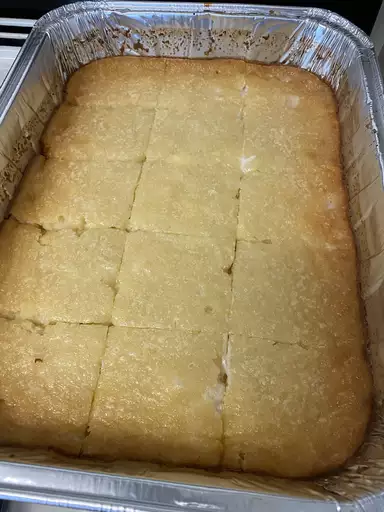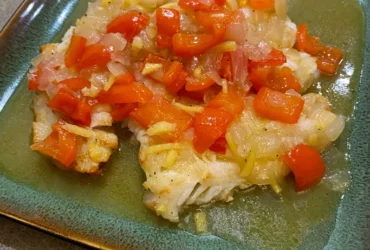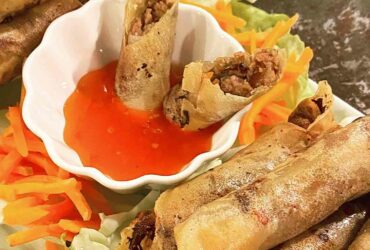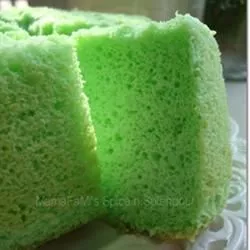Cassava Tubers
Cassava tubers are a staple ingredient in many tropical countries, particularly in Africa and Latin America, where they are commonly known as yuca or manioc. They belong to the Manihot esculenta species and are a rich source of carbohydrates, making them an ideal base for various dishes, including desserts like cassava cake.
The tubers have a starchy, slightly sweet flavor, which is often compared to a cross between potatoes and sweet potatoes. When cooked, they become soft and creamy, with a hint of nuttiness that pairs well with spices, herbs, and other ingredients.
There are two main varieties of cassava tubers: the bitter variety (Manihot esculenta) and the sweet variety (Manihot glaziouii). The bitter variety is more common and is often used in savory dishes, while the sweet variety is preferred for desserts like cassava cake.
To use cassava tubers in cooking, they must first be peeled and grated or boiled to remove their toxic compounds. Freshly harvested cassava tubers are high in cyanide, a naturally occurring toxin that can be deadly if ingested in large quantities. Cooking the tubers removes some of this toxicity, making them safe for consumption.
For baking cassava cake, it’s essential to use a sweet variety of cassava tuber and to cook it properly before grating or mashing it. This helps to break down its starches and release their natural sweetness, resulting in a delicious and moist dessert.
Cassava tubers can be purchased at most Asian or Latin American markets, particularly in cities with large immigrant populations. They are often sold frozen, which makes them easily available for use in cassava cake recipes.
2 large cassava tubers, peeled and grated
To prepare this delicious Cassava Cake, you will need to start with the right ingredients. Here’s a breakdown of what you’ll need:
Main Ingredients
- 2 large cassava tubers: These are the stars of our Cassava Cake recipe. Make sure to choose tubers that are firm and free of any blemishes.
Now, let’s talk about preparing these cassava tubers. To do this, you’ll need to follow a few simple steps:
- Peeled and grated: The first step is to peel the cassava tubers using a vegetable peeler or a sharp knife. Be careful, as the skin of the cassava can be quite tough.
- Grated: Once peeled, use a box grater or a food processor with the shredding attachment to grate the cassava tubers. You want to end up with a mixture that resembles coarse breadcrumbs.
This will yield about 2 cups of grated cassava, which you can then use in your Cassava Cake recipe. Make sure to squeeze out as much liquid from the grated cassava as possible using a cheesecloth or a fine-mesh strainer before adding it to your mix.
Sugar and Spices
The key to a rich and flavorful cassava cake lies in its ingredients, particularly sugar and spices.
Cassava flour serves as the primary ingredient, providing a nutty flavor and dense texture that complements other components perfectly.
A fundamental aspect of baking is understanding the role of Sugar, which adds sweetness to balance out savory flavors in cassava cake recipes.
Granulated sugar dissolves easily in liquids, making it essential for many recipes including this one, where a significant amount is used in both the batter and topping mixture.
To add depth and warmth to the cassava cake, various spices are often employed. Ground cinnamon is commonly used, adding its distinctively sweet and spicy aroma to baked goods.
The aromatic essence of ground ginger pairs well with cinnamon’s sharpness in balancing the sweetness from the sugar content in cassava cakes.
Some recipes may also incorporate additional spices like nutmeg or cardamom for their unique flavor profiles, but ground cinnamon and ginger serve as staples in many variations.
When selecting the ideal blend of sugars for a cassava cake recipe, it’s crucial to consider their varying effects on flavor and texture.
Brown sugar offers a rich, caramel-like sweetness that pairs well with nuts or dried fruits, while refined sugar provides an intense sweetness often used in conjunction with spices like cinnamon and ginger.
The judicious balance of sugars, along with the strategic use of spices such as ground cinnamon and ginger, will undoubtedly elevate your cassava cake from a basic baked good to a culinary masterpiece that impresses even the most discerning palates.
1 cup granulated sugar
Cassava cake is a delicious dessert that originated from Latin America, and it’s made with a variety of ingredients, one of which is granulated sugar.
Granulated sugar, also known as white sugar or table sugar, is the type of sugar commonly used in baking, including in cassava cake recipes.
What is Granulated Sugar?
Granulated sugar is a sweet crystalline powder extracted from either sugarcane or sugar beets.
The production process involves refining and purifying the sugar to remove any impurities and produce a pure white crystal that dissolves easily in water.
Importance of Granulated Sugar in Cassava Cake Recipe
In a cassava cake recipe, granulated sugar serves several purposes:
- It adds sweetness to the dessert, balancing out the savory flavor of the cassava root.
- It helps to bring out the natural flavors of the other ingredients in the recipe.
- It plays a crucial role in browning and caramelization during baking, giving the cake its characteristic golden-brown color and crispy edges.
1 tsp baking powder
Tips for Using Granulated Sugar in Cassava Cake Recipe
To get the most out of granulated sugar in your cassava cake recipe:
- Make sure to use the right amount called for in the recipe, as too much or too little sugar can affect the texture and flavor of the cake.
- Use fresh granulated sugar for best results, as old or stale sugar may not dissolve properly and can give a grainy texture to the cake.
By understanding the importance of granulated sugar in cassava cake recipe, you’ll be able to create a delicious and authentic dessert that will impress your friends and family!
1/2 teaspoon salt
The Cassava Cake recipe requires a variety of ingredients to bring out the rich and distinct flavor of cassava, a staple root vegetable in many tropical countries. To add depth and complexity to the cake, it’s essential to use the right balance of ingredients.
For this recipe, we’ll be focusing on the salt content, specifically the 1/2 teaspoon called for in the ingredient list. Salt is a fundamental seasoning that enhances flavors, controls bacterial growth, and helps preserve food. In this context, the salt serves multiple purposes:
Firstly, salt balances out the natural sweetness of cassava, preventing it from becoming overly sweet or cloying. This balance ensures that the cake remains well-rounded and pleasing to the palate.
Secondly, salt helps to enhance the flavors of other ingredients in the recipe, such as coconut milk, eggs, and spices. By adding a pinch of salt, we can bring out the rich aromas and textures of these ingredients, creating a more layered and interesting flavor profile.
Lastly, salt plays a crucial role in controlling bacterial growth and preserving food. Cassava is a starchy root that’s prone to spoilage if not stored properly. The salt content helps to inhibit bacterial growth, extending the shelf life of the cake and ensuring it remains safe for consumption.
When using salt in this recipe, it’s essential to remember that a little goes a long way. Too much salt can overpower the other flavors and make the cake taste unpleasantly salty. Therefore, we recommend sticking to the 1/2 teaspoon measurement specified in the ingredient list.
The choice of salt is also crucial when making this Cassava Cake recipe. We recommend using flaky sea salt or kosher salt, as they have a more delicate flavor and texture than regular table salt. This will help to add a touch of sophistication and subtlety to the cake, rather than overpowering it with an overly salty taste.
In summary, the 1/2 teaspoon of salt called for in this Cassava Cake recipe is essential for balancing out flavors, enhancing textures, and preserving food. By using the right type and amount of salt, we can create a rich and complex flavor profile that will leave our guests wanting more.
1/4 teaspoon ground cinnamon
To make the Cassava Cake, you will need the following ingredients:
Main Ingredients:
- 1 large cassava root, peeled and grated
- 1 cup granulated sugar
- 2 large eggs
- 1/4 teaspoon salt
Add-ins:
- 1/4 teaspoon ground cinnamon
- 1/2 cup melted unsalted butter
- 1 can sweetened condensed milk (14 ounces)
- 1 teaspoon vanilla extract
- Optional toppings: chopped nuts, dried coconut flakes, or chocolate chips
Other:
- Pan greasing agent (butter or cooking spray)
- Cooking spray for the bundt pan
- Confectioners’ sugar for dusting (optional)
Remember to adjust the amount of sugar and spices according to your personal taste preferences. This recipe is a classic Filipino dessert that can be served at room temperature or warmed up, making it perfect for potlucks, parties, or even as a special treat for family gatherings.
h2>Wet Ingredients
Wet Ingredients
The wet ingredients are an essential component of the cassava cake recipe, providing moisture, flavor, and texture to the final product. These ingredients play a crucial role in bringing all the dry ingredients together, creating a harmonious balance of flavors and textures.
The following are some common wet ingredients used in cassava cake recipes:
Eggs
Large eggs are often used as a primary source of moisture and richness in cassava cakes. They provide protein structure, emulsification properties, and contribute to the overall tenderness of the cake.
Coconut milk
Coconut milk is a popular ingredient in many Filipino desserts, including cassava cake. It adds a rich, creamy texture and a subtle coconut flavor that complements the sweetness of the cassava.
Evaporated milk
Evaporated milk is another common wet ingredient used in cassava cakes. It adds moisture, tenderness, and a slightly sweet flavor to the final product.
Vegetable oil or melted butter
Vegetable oil or melted butter are often used as a substitute for other fats or oils in cassava cake recipes. They add moisture and help to balance out the sweetness of the sugar and the starchiness of the cassava.
Freshly squeezed milk
Some recipes may call for freshly squeezed milk, which adds a unique flavor and texture to the final product. This is especially true in traditional Filipino recipes where fresh milk is readily available.
In addition to these wet ingredients, it’s essential to note that the type of cassava used can also impact the overall taste and texture of the cake. Some popular varieties include:
Yuca or manioc
These starchy tubers are commonly used in Latin American cuisine and add a distinct flavor and texture to cassava cakes.
Kamote or sweet potato
These sweet and nutty tubers can be used as a substitute for yuca or manioc, adding a slightly sweeter flavor profile to the final product.
In summary, the wet ingredients in cassava cake recipes play a crucial role in balancing out the flavors and textures of the final product. By understanding the properties and functions of these ingredients, bakers can create a harmonious and delicious cassava cake that is sure to please even the most discerning palate!When it comes to preparing a traditional Filipino dessert like Cassava Cake, understanding the importance of ingredients such as milk and eggs is crucial.
Milk is one of the main dairy products used in this recipe, providing moisture and richness to the cake’s texture.
Cassava cakes typically call for whole milk or low-fat milk due to its high fat content that enhances flavor and tenderness.
On the other hand, eggs serve as an essential binder in cassava cake recipes, holding all the ingredients together while maintaining their shape and structure.
Ingredients Required
- Grated cassava or yuca
- Milk (whole or low-fat)
- Eggs (large-sized)
- All-purpose flour
- Granulated sugar
- Baking powder
- Salt
- Unsalted butter, melted
- Grated cheese (optional)
- Pineapple chunks (optional)
- Vanilla extract
The combination of eggs and milk also adds a touch of creaminess to the cake’s flavor profile.
Egg Yolks vs. Egg Whites
- Using only egg yolks can result in a richer, more custard-like texture.
- Mixing in egg whites will introduce air and create a lighter consistency.
To balance the sweetness of the cake, using unsalted butter helps to eliminate excess saltiness while maintaining moisture retention.
1 cup whole milk
Milk
is a crucial ingredient in many recipes, and for our Cassava Cake Recipe, we require 1 cup whole milk. The type of milk used can affect the texture and flavor of the cake, which is why we prefer whole milk for its rich and creamy properties.
Whole milk contains 3.5% fat content, making it an excellent choice for baking cakes that require moisture and tenderness. The high fat content in whole milk also contributes to the overall flavor of the cake, giving it a richer taste. Using whole milk
instead of low-fat or skim milk will result in a more indulgent and satisfying cassava cake.
It’s worth noting that you can substitute whole milk with other types of milk, such as 2% or skim milk, but keep in mind that the flavor and texture may vary slightly. If you’re looking for a lighter version of the cassava cake, you can use low-fat or skim milk, but if you want a traditional and rich cassava cake, stick with whole milk.
In our recipe, we recommend using fresh whole milk to ensure the best flavor and texture. If you’re unable to find fresh whole milk, you can use store-bought or pasteurized whole milk. However, be sure to check the expiration date and store it properly in the refrigerator to maintain its freshness.
2 large eggs
Cassava cake is a traditional dessert from the Philippines that typically consists of grated cassava, sugar, eggs, and coconut milk. In this recipe, we will focus on one of the key ingredients: large eggs.
Large eggs are a crucial component in cassava cake, serving multiple purposes in the final product. They add richness, moisture, and structure to the dessert. The protein in the eggs helps bind the grated cassava together, creating a cohesive and tender crumb.
The fat content in the eggs also contributes to the overall texture of the cassava cake. When cooked, the egg yolks release their fat, which helps keep the cake moist and flavorful.
In addition to their functional properties, large eggs also provide flavor to the cassava cake. The yolks contain a small amount of sulfur compounds that give the cake a subtle savory taste, while the whites contribute a slightly sweet flavor.
When selecting large eggs for your cassava cake recipe, it’s essential to choose high-quality eggs that are fresh and free-range. Free-range eggs typically have better flavor and texture than conventionally raised eggs due to the birds’ varied diet and exercise routine.
The ideal size for large eggs can vary depending on the country or region you’re from. In general, a large egg is around 2.5-3 inches long and weighs about 50-60 grams. When shopping for eggs, look for those with a clean, dry exterior and a visible air pocket in the shell.
When incorporating large eggs into your cassava cake recipe, remember to separate the whites from the yolks before adding them to the batter. This ensures that the egg whites can be beaten until they become frothy, which adds volume and structure to the final product.
Finally, when using large eggs in your cassava cake recipe, don’t overmix the batter, as this can cause the eggs to break down and result in a dense or tough texture. Mix the ingredients just until they come together in a cohesive mass, then stop mixing immediately.
Oil and Flavorings
Cassava cake is a rich and moist dessert that originated from Africa and has since gained popularity worldwide. To make a delicious cassava cake, you will need to choose the right ingredients, oil, and flavorings.
Here are the necessary ingredients for a traditional cassava cake:
- Cassava flour (also known as yuca or manioc): 2 cups
- All-purpose flour: 1 cup
- Baking powder: 1 teaspoon
- Salt: 1/4 teaspoon
- Granulated sugar: 3 tablespoons
- Eggs: 2 large eggs, at room temperature
- Grated coconut (optional): 1/2 cup
Oil is an essential component of cassava cake, as it adds moisture and tenderness to the final product. You can use either butter or oil for this recipe; however, we recommend using a neutral-tasting oil like canola, grapeseed, or coconut oil.
For flavorings, you have several options: vanilla extract is a classic choice that pairs well with cassava, while grated coconut adds a lovely texture and extra flavor. If you want to give your cassava cake an extra kick, try using rum or orange liqueur – just be sure to adjust the amount according to taste!
Here are some guidelines for selecting oil:
- Canola oil: neutral flavor and high smoke point
- Grapeseed oil: light, nutty flavor and high smoke point
- Cooking spray or coconut oil: rich, buttery flavor (use sparingly)
When it comes to choosing the right amount of oil, start with 1 cup and adjust according to your preference. Cassava cake can become quite dense if over-oiled, so be mindful of this when mixing the batter.
- Best LeadsGorilla Alternatives for 2025 - April 22, 2025
- Best Leadzai Alternatives for 2025 - April 22, 2025
- Best LeadSwift Alternatives for 2025 - April 21, 2025













